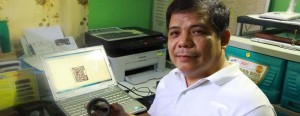
MANILA, Philippines – How his passion turns to invention and how the government is scaling up this invention is Junior De Jesus’ story. De Jesus, 46, comes from a family of limited means. But this did not deter him to pursue his interest in electrical devices. He took up a vocational course as an electrical and electronics technician.
De Jesus has been developing various electrical devices since early 2000, back when he and his family were in Nueva Ecija. He knew he was doing useful products because the people in the province were buying his wares, but he didn’t realize then that he was, in the process, engaged in inventions. His devices were a hit in the areas which didn’t have electric supply at the time.
“Pero hindi ko alam na imbensyon na pala yung ginagawa kong ganun (But I didn’t know what I was doing was in some way an invention),“ he said.
Later, in Valenzuela City, he worked in a private company and he met his future patent partner Rolly Atienza who encouraged him to develop what later became Highmax Turbo Power Simulator (HTPS). The HTPS is a small device installed in a vehicle to boost its fuel consumption.
De Jesus explained that normally, a vehicle burns only up to 70 percent of the injected fuel, thus leaving the 30 percent unused, wasted fuel resulting in smoke emission. But the HTPS, when installed in a vehicle, helps the engine burn almost 100 percent of the fuel. This gives off more power, enabling the vehicle to run faster without having to add more fuel.
In effect, HTPS helps your vehicle run efficiently by maximizing consumption of fuel and it helps make for a cleaner environment by its near-zero smoke emission.
The HTPS device is an invention that has gone through almost a decade of product development.
De Jesus started with an electrical ballast that he ran on several tests and adjustments until he reached his desired performance. He went abroad for a while and he had more time to tinker with his invention. He eventually returned to the country and focused on further developing his product. His patent partner gave him PhP 8,000 to develop his product. But product development is a costly thing. He shelled out about PhP 100,000 of his own money in conducting further tests. In 2010, HTPS was granted a patent.
De Jesus considers the financial capital as among the primary challenge since his production materials and manpower is dictated by his available funds. He had been marketing HTPS on a small scale, 15 to 20 units per month.
This was until he joined inventors’ organizations when,as member of the Filipino Inventors Society, he got wind of an exhibit at the Technological Institute of the Philippines, Cubao organized by the Department of Science and Technology-National Capital Region (DOST-NCR). When he visited the DOST-NCR office, he also dropped by the Technology Application and Promotion Institute (TAPI), a DOST agency which assists the Filipino inventors.
De Jesus presented his HTPS invention to TAPI, showed them what it can do, and highlighted the benefits that can be derived from adopting his technology. He was given a checklist of requirements which he complied with immediately. He was surprised that in about two months, his request for assistance and the corresponding fund was approved and available.
“Naririnig ko dati na pag sa gobyerno, mahirap, matagal. Pero ang naranasan ko, hindi naman mahirap at hindi rin matagal. Nalaman ko na basta kumpleto ka sa requirements, mabilis maayos ang tulong na kailangan mo (I used to hear that dealing with government takes a lot of time and it can be difficult. But based on my experience, it didn’t take me very long. I’ve learned that as long as your requirements are complete, processing of your needed assistance is faster),” De Jesus recounted his experience with TAPI.
De Jesus’ problem with capital has been addressed by the government support he obtained early this year. Before the DOST-TAPI assistance, the HTPS came in a small plastic box and the PCB board prints inside was done by hand. But with the government financial assistance, De Jesus was able to improve his technology. Highmax now comes in a more compact package made of zinc, with better quality electrical parts that spells durability. He also acquired computers and printer so he can make adjustments in design and packaging.
With his product development made possible by government support, De Jesus is more confident that he is now ready to produce the HTPS for a larger market. He wants to focus on production and leave the marketing aspect to the experts. Marketing, he said is the second challenge, next to lack of capital.
“Naniniwala ako na may mga taong ang talino ay nasa pagkukumbinse ng iba. Ang aking talento ay ang mabilis ko na nagagawa pag may pinagawa sa aking improvement sa design (I believe that there are people who are talented in convincing others. My talent is on improving designs quickly when asked),” he said.
In the past, only two people worked in the production of HTPS units, but now there are five. He is currently in the process of negotiation with both the public and private sectors for mass marketing of his product. He hopes to employ people from his community in Valenzuela and move to a bigger place when his production goes full scale.
De Jesus hopes that more people will learn the value of his invention in terms of cutting down pollution and in engine efficiency.
“Gusto ko sana na itong Highmax man lamang ay maging munting maiambag ko para sa ikabubuti ng ating kapaligiran, (I want Highmax to be my small contribution for the environment).” De Jesus said.











Leave a Reply